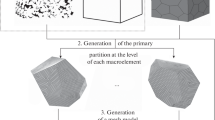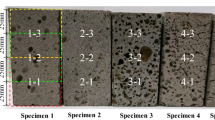Abstract
We present a new parallel numerical technique to estimate the effective elastic parameters of a rock core sample from three-dimensional Computed Tomography (CT) images. Our method is based on the energy equivalence principle and a new approach to solve 3D static elasticity problem by iterative relaxation technique. We determine the elastic moduli by the parallel computation of potential energy of the elastic deformations arising in the sample under some homogeneous strains applied to the boundary thus simulating effects occurring in laboratory measurements. The obtained numerical results are discussed. The proposed method is verified using homogeneous samples with specified properties as well as for layered materials with effective parameters obtained according to the Schoenberg method. The effective parameters of a real carbonate core sample obtained from 3D CT-image are presented.
Access this chapter
Tax calculation will be finalised at checkout
Purchases are for personal use only
Similar content being viewed by others

References
Christensen, R.: Introduction to Mechanics of Composite Materials, 1st edn. Wiley, New York (1979)
Sendetski, J. (ed.): Composition Materials, vol. 2. Mechanics of Composition Meterials [Russian translation]. Mir, Moscow (1978)
Shermergor, T.: The Theory of Elasticity of Microinhomogeneous Media [Russian translation]. Nauka, Moscow (1977)
Aboudi, J.: Mechanics of Composite Materials: A Unified Micromechanical Approach. Elsevier Science, Amsterdam (1991)
Zhang, W., Dai, G., Wang, F., Sun, S., Bassir, H.: Using strain energy-based prediction of effective elastic properties in topology optimization of material microstructures. Acta Mechanica Sinica 23(1), 77–89 (2007)
Kostin, V., Lisitsa, V., Reshetova, G., Tcheverda, V.: Parallel algorithm with modulus structure for simulation of seismic wave propagation in 3D multiscale multiphysics media. In: Malyshkin, V. (ed.) PaCT 2017. LNCS, vol. 10421, pp. 42–57. Springer, Cham (2017). https://doi.org/10.1007/978-3-319-62932-2_4
Schoenberg, M., Muir, F.: A calculus for finely layered anisotropic media. Geophysics 54(5), 581–589 (1989)
Landau, L.D., Lifshitz, E.M.: Mechanics. Nauka, Moscow (1988)
Virieux, J.: P-SV wave propagation in heterogeneous media: Velocity-stress finite-difference method. Geophysics 51, 889–901 (1986)
Vishnevsky, D., Lisitsa, V., Tcheverda, V., Reshetova, G.: Numerical study of the interface errors of finite-difference simulations of seismic waves. Geophysics 79, T219–T232 (2014)
Acknowledgements
This work was supported by the Russian Foundation for Basic Research, Grant 16-05-0800, 18-05-00031, 18-01-00579, 18-41-540016. The research is carried out using the equipment of the shared research facilities of HPC computing resources at Lomonosov Moscow State University, Joint Supercomputer Center of RAS and the Siberian Supercomputer Center.
Author information
Authors and Affiliations
Corresponding author
Editor information
Editors and Affiliations
Rights and permissions
Copyright information
© 2019 Springer Nature Switzerland AG
About this paper
Cite this paper
Reshetova, G., Khachkova, T. (2019). Parallel Numerical Method to Estimate the Effective Elastic Moduli of Rock Core Samples from 3D Tomographic Images. In: Dimov, I., Faragó, I., Vulkov, L. (eds) Finite Difference Methods. Theory and Applications. FDM 2018. Lecture Notes in Computer Science(), vol 11386. Springer, Cham. https://doi.org/10.1007/978-3-030-11539-5_52
Download citation
DOI: https://doi.org/10.1007/978-3-030-11539-5_52
Published:
Publisher Name: Springer, Cham
Print ISBN: 978-3-030-11538-8
Online ISBN: 978-3-030-11539-5
eBook Packages: Computer ScienceComputer Science (R0)



